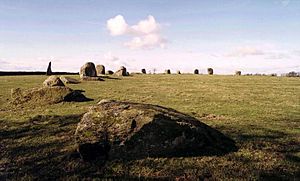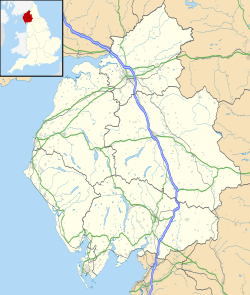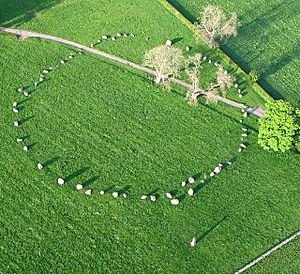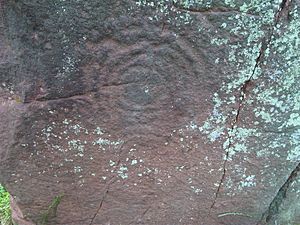Long Meg and Her Daughters facts for kids

The monolith Long Meg and the southern
arc of the circle, viewed from the east |
|
| Location | Little Salkeld |
|---|---|
| Coordinates | 54°43′41″N 2°40′04″W / 54.72794°N 2.66765°W |
| Type | Stone circle |
| History | |
| Periods | Neolithic |
| Site notes | |
| Public access | Yes |
Long Meg and Her Daughters is a very old and famous stone circle in Cumbria, North West England. It's near a town called Penrith. This amazing place was built a long, long time ago, during the Bronze Age. That was between 3,300 and 900 BCE!
It's one of about 1,300 stone circles found in the British Isles. Long Meg and Her Daughters is the sixth-largest stone circle in this part of Europe. It's a bit smaller than other famous circles like Stanton Drew and the Ring of Brodgar.
The site has 59 stones arranged in an oval shape. About 27 of these stones are still standing upright today. The oval is about 340 feet (100 meters) long. There might have been as many as 70 stones originally.
The tallest stone is called Long Meg. She is a huge stone, about 12 feet (3.6 meters) tall. She stands about 80 feet (25 meters) away from the main circle of stones, which are known as her "Daughters." Long Meg has special ancient drawings carved into her. These include cup and ring marks, a spiral, and circles within circles.
Scientists have used special cameras to look at the ground from above. They found signs of other old enclosures near Long Meg that were built even earlier. There's also a smaller stone circle nearby called Little Meg. Long Meg and Her Daughters was even used as a place to film the movie Sightseers in 2012!
Contents
Where is Long Meg and Her Daughters?
Long Meg and her Daughters is part of a group of ancient sites near Penrith. This area has many old monuments. Besides Long Meg, you can find the Little Meg circle nearby. There's also a very impressive ancient earthwork called Mayburgh. Another partly destroyed earthwork is called King Arthur's Round Table.
These stone circles and earthworks are often found near old travel routes. For example, the Long Meg complex is close to the River Eden. Other sites are near the River Eamont and River Lowther. This suggests that these places were important meeting points in ancient times.
Long Meg and her Daughters sits on a raised area above the water. There's an old ditch around a nearby farm that seems to be even older than the stone circle. This ditch might have been part of a large enclosure. There are also springs nearby, which could have been important to the people who built these sites.
How Was It Built?
The whole monument is very large, about 120 yards (109 meters) by 100 yards (93 meters) across. Long Meg herself is the tallest stone. She is about 12 feet (3.8 meters) high and weighs around 9 tons!
Long Meg is made of red sandstone. This stone probably came from the nearby River Eden or hills. The stones in the circle, the "Daughters," are made of a different type of rock called rhyolite. These stones were likely moved here by glaciers a long time ago.
There are two very large stones placed on the east and west sides of the circle. There are also two special "portal" stones on the southwest side. Long Meg herself is placed in a way that lines up with where the sun sets in the middle of winter. This shows that the builders knew a lot about the sun's movements.
One side of Long Meg has natural crystals. The side facing the circle has spirals and other ancient art carved into it. The center of the circle might have been dug out a bit. Some old reports say there were two piles of stones in the middle, possibly for later burials.
Some of the stones in the circle are made of a special type of quartz crystal. These seem to have been chosen on purpose. They are placed at certain points in the circle to mark important times of the year. These could be things like sunsets or the start of different seasons.
The builders also seemed to use different colored stones. Red, white, and blue/grey stones are common. Long Meg is red. There might even be a red stone on the east side of the circle that lines up with the sunrises and sunsets during the spring and autumn equinoxes (when day and night are equal length). The stones might have been used to track the moon's movements too.
Ancient Rock Art
The Long Meg stone has many interesting carvings on the side that faces the stone circle. These carvings are split into three parts. In the middle, you can see a cup shape surrounded by three rings. There's also a spiral with four turns and many curved lines.
The lower part of the stone has faint figures, another spiral, and more cup and ring marks. The top part has faint rings, oval shapes, and other markings. Some of the stones in the circle itself also have artificial markings carved into them. These carvings are a mystery from the past!
When Was It Built and Why?
The large ditch near the stone circle was probably built during the Neolithic period. This was an even earlier time than the Bronze Age. If the stone circle was built after this ditch, it would be from the early Bronze Age. It's also possible that the tall Long Meg stone was put there at a different time than the circle of Daughters.
We don't know exactly why Long Meg and Her Daughters was built. It was more than just a burial place. Experts have many ideas about its purpose. One idea is that it was a place where people gathered. This might have happened at certain times of the year.
During these gatherings, people might have held special ceremonies. They could have also traded goods or met up with others. The "certain times of the year" might have been figured out using the way the stones line up with the sun and moon. Building the circle itself, perhaps over many years, might have been part of its purpose too.
Folklore and Legends
Many interesting stories and legends are told about Long Meg and Her Daughters. The most famous one says that the stones were once a group of witches. A wizard from Scotland named Michael Scot turned them into stone.
The legend says that you can never count the stones correctly. If someone manages to count them twice and gets the same number, the magic spell will be broken. Or, it might bring very bad luck! Another story says that if you walk around the circle, count the stones correctly, and then put your ear to Long Meg, you will hear her whisper.
The name "Long Meg" is said to come from a local witch named Meg of Meldon. She lived in the early 1600s. From certain angles, the Long Meg stone looks like the side profile of a witch. However, the real Meg of Meldon lived quite far away from these stones.
Some long animal bones were found buried at the site a long time ago. People in the past might have thought these were the bones of a giant!
See also
 In Spanish: Long Meg and Her Daughters para niños
In Spanish: Long Meg and Her Daughters para niños




